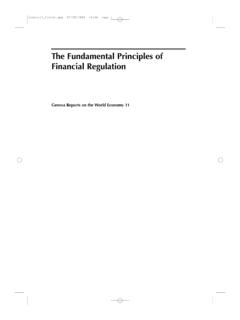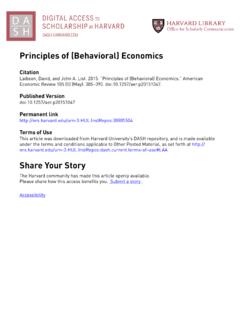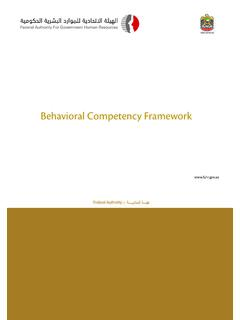Transcription of Behavioral Finance: History and Foundations
1 See discussions, stats, and author profiles for this publication at: Behavioral finance : History and Foundations Article March 2017. CITATIONS READS. 0 132. 1 author: Pavlo Illiashenko Tallinn University of Technology 2 PUBLICATIONS 0 CITATIONS. SEE PROFILE. Some of the authors of this publication are also working on these related projects: Culture and Behavioral Biases (among retail investors) View project Behavioral finance : its History and Foundations , household and corporate Behavioral finance , debiasing View project All content following this page was uploaded by Pavlo Illiashenko on 08 April 2017. The user has requested enhancement of the downloaded file. All in-text references underlined in blue are added to the original document and are linked to publications on ResearchGate, letting you access and read them immediately. Behavioral finance : History and Foundations Behavioral finance : History and Foundations1.
2 Avlo Illiashenko P. Tallinn University of Technology, School of Business and Governance E-mail: Recent evidence suggests that ideology has the potential to affect academic research in economics and that exposure to a wide range of approaches may increase intellectual diversity, eventually leading to better decisions. Therefore, writing a literature review in Behavioral finance , in principle, can bring benefits to a wide range of readers, especially since the field of Behavioral finance itself has already grown into a complex web of related but distinct sub-fields and reached a stage when it can guide policy decisions. This review differs from the existent ones as it focuses on the History of the field and its psychological Foundations . While the review of psychological Foundations is necessary to appreciate the benefits of a Behavioral approach and understand its limitations, even a brief historical detour may provide a compelling case against a na ve dichotomy between Behavioral and classical finance .
3 JEL codes: G02, B26, D03, D14. Key words: Behavioral finance , classical finance Introduction Federal Reserve research had been unable to find economies of scale in banking beyond a modest size [ ]. citing such evidence, I noted that "megabanks being formed by growth and consolidation are increasingly complex entities that create the potential for unusually large systemic risks in the national and international economy should they fail" [ ]. Regrettably, we did little to address the problem. Alan Greenspan (2010). The Crisis, Brookings Papers on Economic Activity. I often wondered as the banks increase in size throughout the globe prior to the crash and since: Had bankers discovered economies of scale that FED research had missed? Alan Greenspan (2014). The Map and the Territory : Risk, Human Nature, and the Future of Forecasting. Reading Alan Greenspan's latest book in 2014, I stumbled upon the posed question. Indeed, had bankers discovered economies of scale that FED research had missed?
4 I wondered if Greenspan ever considered a Behavioral explanation (hubris hypothesis, Roll, 1986) for the wave of mergers and consolidations in the banking sector or an institutional explanation (Brewer and Jagtiani, 2013) that states that banks receive special treatment after growing over a too-big-to-fail threshold? And if not, was it because these explanations were rejected after thorough investigation or because real human beings overweight their prior beliefs and reluctantly accept ideas that contradict them, as most Behavioral economists believe to be a quite accurate description of what we all do? The questions are, obviously, rhetorical. Yet, as the law of the instrument (Kaplan, 1964) states that we tend to over-rely on familiar tools and ideas, the same way scholars in economics and finance may fail to approach important issues from multiple angles. The degree to which finance and economics in general suffer from a lack of diversity of ideas is a matter of discussion.
5 However, the evidence indicates that ideology influences the results of academic research in economics and leads to sorting into fields, departments, and methodologies (Jelveh et al., 2015). If an ideology and personal background affect academic views, then exposure to a wide range of approaches should increase intellectual diversity, which in turn should lead to better decisions. Therefore, writing a literature review in Behavioral finance still makes sense even though the field lost its controversial status a long time ago (Thaler, 1999a) and nowadays is included in standard textbooks like Hens and Rieger (2016). Namely, I can see at least two reasons. 1 Acknowledgments. The author thanks Michiru Nagatsu, Markku Kaustia, and anonymous reviewers. 28 VISNYK OF THE NATIONAL BANK OF UKRAINE | March 2017. Behavioral finance : History and Foundations First, Behavioral finance has already grown into a complex web of related but distinct sub-fields of research and providing an overview of recent studies may bring some benefits to the otherwise deeply specialized researchers.
6 Secondly, finance plays an enormous role in most domains of life at virtually any level of aggregation from individuals to governments. Thus, the range of potential readers of the literature review extends beyond one profession. For instance, it is my strong conviction that Behavioral finance had reached a stage when it should guide related policy decisions. Interestingly enough, there is no simple answer to what Behavioral finance actually There are many ways to define the field and its boundaries, and they mostly depend on the personal perspective of a researcher. For example, to Eugen Fama, a pioneer and a vocal champion of the efficient market hypothesis, Behavioral finance is a body of literature mostly preoccupied with attacks on market efficiency (Fama, 2014). On the other side of the spectrum, consider Richard Thaler, a founding father of Behavioral finance who made a substantial effort to establish the field as a legitimate part of classical finance (Thaler, 2015.)
7 Tells a thrilling History of Behavioral economics and finance from the perspective of the author). He defines Behavioral finance as simply open-minded finance (Thaler, 1993). Behavioral finance may also be defined by the modifications it has made to a standard finance framework. Here is a catch-all description given by Statman (2014): Behavioral finance substitutes normal people for the rational people in standard finance . It substitutes Behavioral portfolio theory for mean-variance portfolio theory, and Behavioral asset pricing models for the CAPM and other models where expected returns are determined only by risk. [ ] Behavioral finance expands the domain of finance beyond portfolios, asset pricing, and market efficiency. It explores the behavior of investors and managers in direct and indirect ways, whether by examining brains in fMRIs or examining wants, errors, preferences, and behavior in questionnaires, experiments, and the field.
8 [ ] Behavioral finance explores saving and spending behavior [ ]. And it explores financial choices affected by culture, fairness, social responsibility, and other expressive and emotional wants. Finally, Behavioral finance is an umbrella-term for a set of research questions which were put together mainly by historical accident. Noah Smith, a Bloomberg View columnist and a former assistant professor of finance at Stony Brook University, identified3 six different streams of research in finance encompassed by Behavioral finance . They range from finance based on informational frictions (starting with seminal works such as Grossman and Stiglitz, 1980; Milgrom and Stokey, 1982) to empirical research on the behavior of individual investors (mostly initiated by Brad Barber and Terry Odean). The difference in definitions may reaffirm the idea that a researcher's background matters. However, any attempt to define Behavioral finance will eventually succumb to the nature of economic agents.
9 Standard finance assumes that its models are populated by agents empowered with such superpowers as limitless cognitive skills and willpower, and on the other hand restrained to pursue only their self-interest. These three unbounded traits (rationality4, self-control, and self-interest) form the basis for a so-called Homo Economicus, which is a model used to approximate the behavior of real human beings in a way that can be operationalized for the sake of building economic models. The word "approximate" is crucial. finance (and economics in general) does not claim that Homo Economicus is a one-to-one representation of real world Homo Sapiens, rather such a portrayal is close enough to reality so we can bear the benefits of the simplification. Naturally, humans may make mistakes, but people will learn over time and, given sufficient incentives, they will think and try harder to make truly rational choices. And if all of this is not enough, the individual mistakes will still be canceled out in the process of aggregation.
10 These are severe assumptions, but this has not stopped the profession from building itself around Homo Economicus. Instead, Behavioral finance highlights that humans behave quite differently from Homo Economicus by embracing findings from psychology and sociology. This difference, no matter how much it may appear trivial, nonetheless has important consequences since real human beings are inclined to make systematic and predictable mistakes referred to as Behavioral biases. Following Thaler and Sunstein (2008), I will label decision makers described in the models of classic finance as Econs while referring to decision makers as viewed by Behavioral finance as Humans. To illustrate the difference between Humans and Econs, consider the classic example known as the "Asian disease problem". (Tversky and Kahneman, 1985). 2 I will not provide a definition of Behavioral finance of my own, while sticking to as much a wide definition as possible throughout this article.







